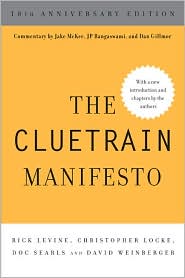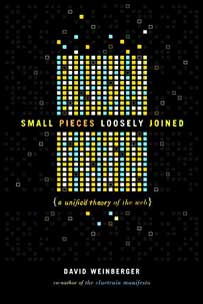March 17, 2009
[berkman] Jeff Howe on crowd sourcing
Jeff Howe of Wired is giving a Berkman lunchtime talk on his book Crowd Sourcing. (He coined the term in 2006.) [Note: I’m live blogging, making mistakes, missing stuff, paraphrasing inappropriately, etc.]
From the beginning, he says, he’s been ambivalent about crowd sourcing. His book is a series of stories showing crowdsourcing’s promise and perils. The book is short on quantitative data, he says. As he was finishing up the edits, he came across a survey of 650 iStockPhoto.com photo contributors. iStock was one of Jeff’s main examples, a stock photo agency that undercut competitors by 99%. They were able to do this because amateur photographers were willing to upload entire libraries of their photos. iStock culled them. iStock runs its corporate decisions past the community. The survey showed that contributors had a rich mix of motivations. He’d like to revisit this question.
Jeff gives his 45 minute book talk in 20 mins: He got interested in crowdsourcing by watching Myspace. “User generated content” doesn’t begin to tap the change that’s taking place. (Plus, he adds, he hates the phrase.) He spent a night searching for user-generated anything to show that it was about more than teenagers making “content.” E.g., John Fluevog Open Source Shoeware names shoes after designs contributed by users. He wrote an article for Wired in June 2006. The term took off.
As an example, he tells the story of the Two Jakes who created a crowdsourced t-shirt company, threadless.com. It created a community of designers and people who like to vote on designs. Revenues in 2007 topped $30M. The community provides the designs, does the marketingt, and Threadless has a mechanism that lets them gauge how much they need quite accurately.
iStockPhoto was bought by Getty, and revenues have continued to climb…over $100M in 2008, with 50% profit margin.
Another example: The way amateur ornithologists have transformed the way ornithology works, Current.tv, the Elements restaurant in DC…
Why did crowdsourcing happen? Lots of amateurs, open source, tools, online communities. The cardinal rule of crowdsourcing: “Ask not what your community can do for you, etc.”
Jeff ends by asking about the study of iStock contributions’ motivations. 80% of iStockers religiously visit the site. The study shows the primacy of the financial motivation. Only 4% of the contributors make their primary living off of photography. The forum gets 37 posts per minute. 80% consider their work profitable, and 20% consider it extremely profitable. iStockers are largely not out to make friends or to network with others. iStockers are unsure that other iStockers can be trusted. This runs counter to how the company portrays them.
Q: I just had a logo made for $250 through LogoTournament. 30-40 designers worked on it from all over the world. The contestants all see one another’s designs.
A: Anectodotally, people seem to love it. There’s also CrowdSpring and 99Designs.
I used worth1000 for cover design. The Berkman folk loved it, but when I posted about it, I got flamed.
A: I understand that crowdsourcing is disruptive. It’s an emotional subject. Creatives can shape the transformation by embracing it.
Q: Your examples largely focused on highly creative forms of work. People do these things on their own as hobbies. How about crowdsourcing that has people transcribing podcasts via MechanicalTurk. Are these two types of crowdsourcing the same phenomenon?
A: MechanicalTurk is for repetitive, boring tasks. I don’t know how to encompass this. This makes the motivation for crowdsourcing more complex. That doesn’t dismay me.
Q: Is the difference about passion?
A: My catchphrase is that passion is the currency of the 21st century.
Q: [me] You position this as a contradiction. But it’s not if you define crowdsourcing as the action of a crowd, etc., and stir in economics: Those with leisure will do it for passion, while the rest will do more boring tasks for money. Unless what matters to you, and to the media that took it up, is that it’s a statement about human motivation.
Q:[eszter] You’re putting too much faith in the study. It’s only 1% of users and the methodology isn’t necessarily rock solid.
A: I called iStock’s founder and he has the same problems with the study.
Q: When I got the book, what was exciting was the possibility of solving altruistic problems. Do you have any examples?
A: GlobalVoices. Transcription services from a mobile phone for nonprofits.
Q: ReCaptcha is a great example. Also, spamornot.org.
Some of the crowdsourced stock photo sites are scams.
Q: Is crowdsourcing exploitative?
A: Sure could be. Professional stock photographers certainly think so.








